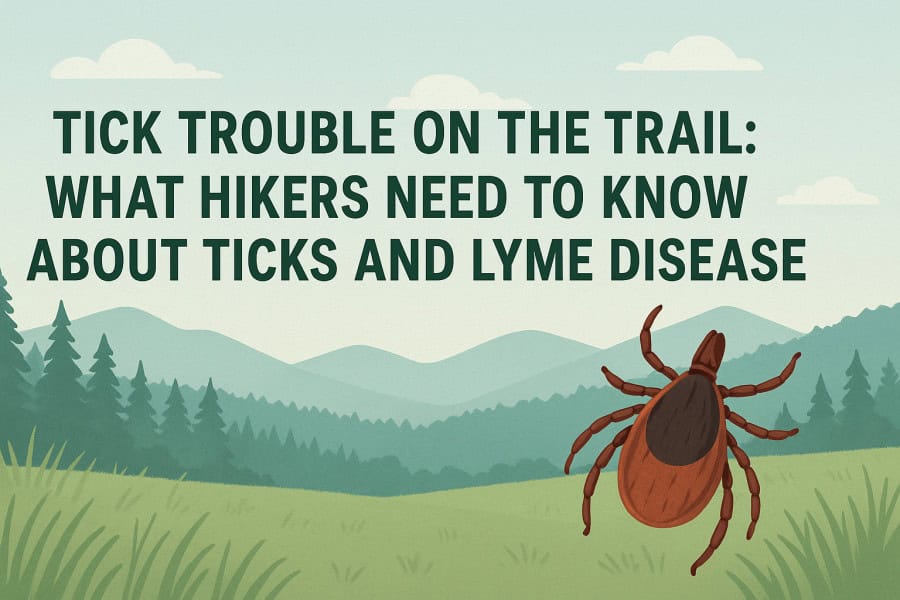Table of Contents
Some links on posts are affiliate links and will earn us a commission from qualifying purchases
There’s nothing quite like the simple joy of heading out for a walk in the countryside – the fresh air, the peaceful sounds of nature, and the sense of freedom. Whether you’re exploring a forest trail, meandering through grassy meadows, or rambling over moorland, getting outside does wonders for your body and mind.
But alongside the beauty of the great outdoors, it’s wise to be aware of some of the less pleasant things we might encounter – and one of those is ticks. These tiny creatures can be easy to miss, but they can carry a serious risk: Lyme disease. As walkers and hikers, it’s important we know how to spot ticks, how to remove them safely, and when to seek medical advice.
Let’s take a look at what you need to know to stay tick-wise on your walks.
What Are Ticks and Why Should You Care?
Ticks are tiny spider-like creatures that feed on the blood of animals, and sometimes humans. You’re most likely to come across them in wooded areas, moorlands, and grassy places, especially where animals like deer or sheep are present. They tend to be more active in warmer months, particularly from spring to autumn.
In most cases, tick bites are harmless. But problems arise when a tick is carrying bacteria that cause Lyme disease – a serious illness that can lead to long-term health issues if not treated quickly. Not every tick carries the disease, but it’s impossible to tell just by looking. That’s why it’s important to take precautions and know what to do if you find one on your skin.
How to Spot a Tick
Ticks are very small, sometimes no bigger than a pinhead when they first latch on, but they grow larger as they feed. After a walk in grassy or wooded areas, it’s a good idea to check your skin for any signs of ticks.
They often favour warm, moist areas of the body, so pay special attention to:
- Behind your knees
- Around your waist
- Under your arms
- Around your groin
- Behind your ears
- Around your ankles or sock line
If you’ve been walking in shorts or short sleeves, make sure to check any exposed skin thoroughly.
A tick may look like a small dark lump or scab. On closer inspection, you might notice a red-black abdomen protruding from the skin.
How to Remove a Tick
If you do find a tick on your skin, don’t panic – but do remove it as soon as possible. The quicker you remove a tick, the lower the risk of infection.
Here’s how to do it safely:
- Use fine-tipped tweezers or a tick removal tool. Avoid using fingers, as squeezing the tick can increase the chance of bacteria being released into your bloodstream.
- Get close to the skin. Grasp the tick as close to the surface of your skin as you can.
- Pull upwards slowly and steadily. Don’t twist or jerk the tick, as this can cause parts of it to break off and remain in the skin.
- Dispose of the tick safely. Place it in tissue and flush it away, or seal it in a bag before putting it in the bin. Never crush a tick with your fingers.
- Clean the bite area. Once the tick is removed, clean the area with antiseptic or soap and water.
When to See Your GP
Most tick bites won’t cause any problems, but there are certain signs to watch out for after being bitten.
You should contact your GP if:
- You develop flu-like symptoms – this could include fever, chills, tiredness, muscle aches, or a headache.
- You notice a distinctive circular rash that spreads outward from the bite. This often looks like a target or bullseye and can appear days or even weeks after the bite.
- The bite becomes infected or doesn’t heal properly.
These could be signs of Lyme disease, which is caused by bacteria transmitted through tick bites. It’s important to get medical help quickly, as Lyme disease is usually treatable with antibiotics if caught early. Left untreated, it can lead to serious and lasting health issues, including joint pain, nerve problems, and fatigue.
How to Prevent Tick Bites in the First Place
Prevention is better than cure, and there are a few simple steps you can take before and during your walk to reduce the risk of tick bites:
- Wear long sleeves and trousers. Tucking trousers into socks can help keep ticks from reaching your skin.
- Stick to paths. Avoid brushing against tall grasses or dense undergrowth.
- Use insect repellent. Choose one that’s effective against ticks and apply it to exposed skin and clothing.
- Do a tick check. As soon as you finish your walk, especially before heading indoors or getting into your car, check yourself and others for ticks. Don’t forget to check your dog if you’ve brought them along.
Final Thoughts
Spending time walking in nature should be enjoyable and worry-free – and it can be, with a bit of tick-awareness. Ticks are part of the countryside, but they don’t need to spoil your adventures. By staying alert, checking yourself regularly, and knowing how to remove ticks safely, you can reduce the risks and keep walking confidently.
So next time you head out on a ramble or a hike, be tick-wise – and don’t forget your tweezers, just in case!
Recent Posts
It's Smart Premium First Aid Kit 110 Pieces Review – Is This Travel Essential Reliable?
When you need a compact first aid kit that’s easy to carry but still thorough, this one from it’s Smart could be a solid choice. After using the kit during our South Downs hiking trip, I found it...
Be Prepared: The Ultimate Guide to First Aid Kits for Hiking
Hiking is a great way to explore the outdoors and stay active, but it also comes with some risks. When you're out on the trail, you may encounter obstacles and accidents that require immediate...


